- Italy Tours Home
- Italy Ethos
- Tours 2023
- Blog
- Contact Us
- Dolomites
- Top 10 Dolomites
- Veneto
- Dolomites Geology
- Dolomiti Bellunesi
- Cortina
- Cadore
- Belluno
- Cansiglio
- Carso
- Carnia
- Sauris
- Friuli
- Trentino
- Ethnographic Museums
- Monte Baldo
- South Tyrol
- Alta Pusteria
- Dobbiaco
- Emilia-Romagna
- Aosta Valley
- Cinque Terre
- Portofino
- Northern Apennines
- Southern Apennines
- Italian Botanical Gardens
- Padua Botanical Garden
- Orchids of Italy
Dolomites Pearls: Discover the Most Magical Places in
the Dolomites.
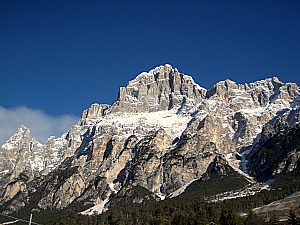
The Dolomites pearls are all those little jewels contained within this magical region (pictured above is the Antelao, King of the Dolomites).
The Dolomites are a wonderful area. They could be seen in many different ways (as a geological, botanical or skiing paradise, for instance), but one way of ‘reading’ them is like an enchanted – almost ‘fairytale’ – realm, populated by innumerable myths and stories. The purpose of this page is therefore to pick up the Dolomites pearls – those magical places surrounded by an almost legendary halo that cannot be missed – and to accompany that presentation with a rich picture gallery that will hopefully entice you to come and explore this wonderful region for yourself.
The choice of places (and images) will inevitably bear on the personal, as some locations may be ‘magical’ to me for some experience I had there – which is what happens to any of us, anywhere we live – but I would also like to concentrate on those spots that are to be considered ‘indisputable’ pearls: after all, to use another analogy, a diamond is a diamond – no matter what we may make of it!
One of such pearls, then, is undoubtedly Cortina and its basin (the ‘Conca di Cortina’, portrayed in the picture below), surrounded at 360 degrees by what is probably the most amazing sequence of Dolomite mountains in the whole region.
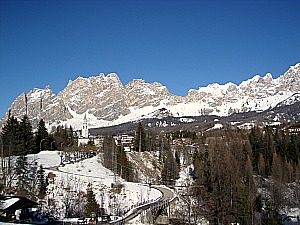
Another one of such places is the Sella group, and the valleys around it – especially those in the Ladin speaking area (Ladin valleys), a region also known as Ladinia: the val Badia/Gadertal, Gardena/Gröden, Marebbe/Enneberg and Fassa.
In these valleys there are some of the most interesting towns and villages in the Dolomites, and also its most celebrated resorts, such as Corvara, Ortisei/St. Ulrich, Selva/Wolkenstein and Canazei, just to name a few – but more information on the individual towns and valleys will be given in the relevant pages.
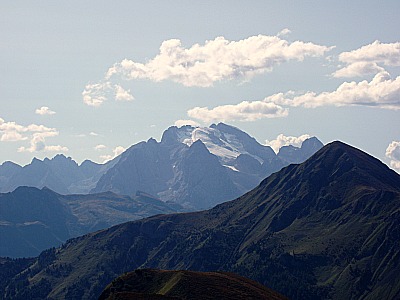
The Dolomite giants – such as the Marmolada (Queen of the Dolomites – pictured above with its glacier), Pelmo (pictured below from the Boite Valley), Civetta and Antelao – undoubtedly form another category of magic, while some other peaks like the Tre Cime di Lavaredo/Drei Zinnen or the Cinque Torri – the Five Towers; see further down the page for pictures – stand on another level altogether, and are famous instead more for their characteristic, unique shape rather than their height: and with this we verge again into the category of the mythical.
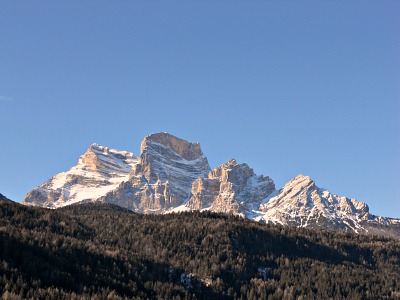
This is an important layer, as these mountains have many legends associated with them, either because of their peculiar shape or the incredible colors that they take at dawn and dusk (a phenomenon known as enrosadira in Ladin).
Undoubtedly, one of the most enchanting legends of the Dolomites is related to the Catinaccio/Rosengarten – a mountain whose name in English we would translate as Rose Garden, and which explains poetically why these rocks take on a crimson tinge at sunset (basically, as the legend goes, this used to be a rose garden then petrified by a spell; see the Catinaccio/Rosengarten page for a full description of the story, while the picture below portays an iconic image of the Tre Cime di Lavaredo/Drei Zinnen – perhaps the most widely acclaimed symbol of the Dolomites).
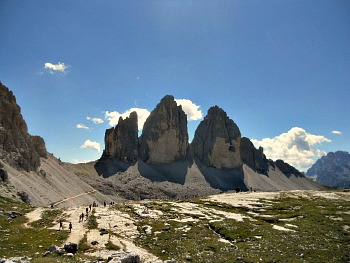
In terms of natural features, there are several Natural Parks in the Dolomites; one National Park – the Dolomiti Bellunesi – and a few Regional Parks: the Dolomiti d’Ampezzo in Veneto, bordering two parks in neighbouring South Tyrol (the Fanes-Sennes-Braies/Fanes-Sennes-Prags, the Dolomiti di Sesto (Sextnerdolomiten) and the Tre Cime (Drei Zinnen; pictured below is an image of the Laghi dei Piani/Bodenseen, a pair of glacial lakes located in the area of the Tre Cime that looks towards the Sextnerdolomiten Natural Park); within this same region (the province of Bolzano/Bozen) there are also the Puez-Odle (Puez-Gaisler) and the Sciliar (Schlern) Natural Parks.
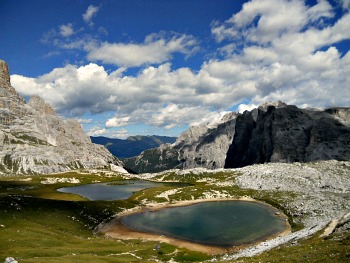
Trentino has two important Regional Parks too: the Paneveggio Regional Park is renowned both for its extensive forest of conifer trees – whose wood was used to build the famous Stradivarius’ violins – as well as for the wondrous massif of the Pale di San Martino (of which is displayed an image below, taken from the uplands at the Val Venegia valley head).
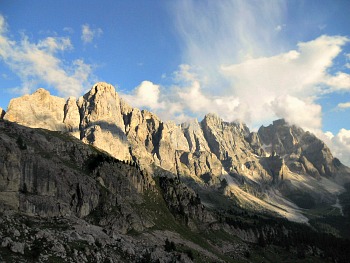
Part of the Adamello-Brenta Regional Park is also in the Dolomites (but only the section covering the jagged peaks of the Dolomiti di Brenta).
These parks usually protect within their boundaries the most relevant mountain groups of the region – such as the ones mentioned above – but not only. There are also other notable features contained within them, such as for instance the lakes – and among these we certainly have to mention at least the Lago di Misurina (near the Tre Cime di Lavaredo/Drei Zinnen; the lake is pictured below with the famous backdrop of the Sorapiss’ northern wall), the Lago di Carezza (Karersee), the Lago di Braies (Pragssee, in the Fanes-Sennes-Braies Natural Park) and the small Lago di Tovel, near the Dolomiti di Brenta, which used to turn a blood-red colour during the summer months because of the presence of a peculiar organism – a minuscule algae, Glenodinum sanguineum – and of course many more.
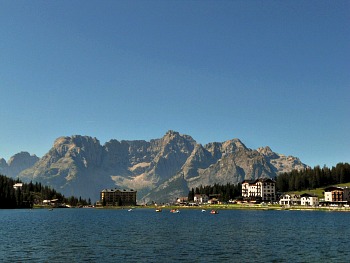
In all of these areas there are wild expanses too – even though it would not be proper to term them as ‘wilderness’, if not for very limited sections here and there. This is because the Dolomites – apart from the more inaccessible rocky expanses – have always been managed by man, especially for cattle farming. In more recent times, also, one has to consider the impact of tourism infrastructures such as ski-lifts and ski-slopes – even though, in the areas mentioned above, the presence of these structures has generally been kept to a minimum.
In any case, pockets of wilderness can still be found – especially so in certain parts of the Dolomiti Bellunesi National Park and in the Dolomiti Friulane Regional Park (the closing image below is taken in the uplands around the Cinque Torri area, at the heart of the Dolomites: this is an emblematic group of the Five Towers, which are portrayed here at the centre of the picture).
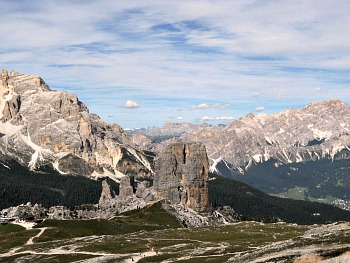
Lastly, if you love sports, do also have a look at the page dedicated to the Dolomite Sports, which focuses specifically on the area of Cadore.
Return from Dolomites Pearls to Dolomites
Return from Dolomites pearls to Italy-Tours-in-Nature
Copyright © 2012 Italy-Tours-in-Nature

New! Comments
Have your say about what you just read! Leave me a comment in the box below.